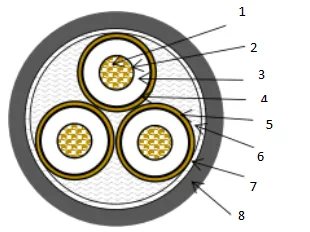10 月 . 08, 2024 22:05 Back to list
Different Varieties of Electrical Cables and Wires Explained
Types of Electric Cable Wire A Comprehensive Guide
Electric cables are integral to modern electrical systems, playing a critical role in transmitting power and data. Understanding the various types of electric cables available is essential for anyone involved in electrical work, whether it's for residential, commercial, or industrial purposes. This article will explore the different types of electric cable wire, their applications, and characteristics.
1. Non-Metallic Sheathed Cable (NM Cable)
Non-metallic sheathed cable, commonly referred to as NM cable or Romex, is widely used in residential wiring for indoor applications. It consists of two or more insulated conductors and a grounding wire, all encased in a flexible plastic sheath. NM cable is lightweight, easy to install, and relatively inexpensive. It is ideal for standard circuit applications, such as lighting and outlets, but should not be used in areas exposed to excessive moisture.
2. Armored Cable (AC)
Armored cable, also known as BX cable, is a type of electrical cable that features a protective metal sheath. This additional layer provides extra protection against physical damage, making it suitable for commercial and industrial applications. Like NM cable, AC cable typically contains insulated conductors and a grounding wire. Its rugged design allows for installation in areas where cables might be exposed to impacts or abrasion.
3. Underground Feeder Cable (UF Cable)
UF cable is designed for underground installation and direct burial. It has a thick, water-resistant outer sheath, providing excellent protection against moisture, chemicals, and physical damage. This type of cable is ideal for outdoor applications such as powering garden lights, pumps, and outdoor buildings. Like NM cable, UF cable commonly includes two or more insulated conductors and a ground wire.
types of electric cable wire

Twisted pair cables are primarily used for data transmission in telecommunications and computer networks. They consist of pairs of insulated copper wires twisted together to reduce electromagnetic interference. There are two main types of twisted pair cables unshielded twisted pair (UTP) and shielded twisted pair (STP). UTP is commonly used in Ethernet networks, while STP offers additional shielding to protect against interference, making it suitable for fully shielded applications.
5. Coaxial Cable
Coaxial cables are widely used for television and internet connections. They consist of a central conductor, an insulating layer, a metallic shield, and an outer insulating layer. The shield helps protect the signal from external interference, allowing for high-frequency signal transmission. Coaxial cables are known for their durability and ability to transmit data over long distances, making them popular for audio and video applications.
6. Fiber Optic Cable
Fiber optic cables represent the latest technology in data transmission. They consist of glass or plastic fibers that transmit data as light signals, offering high bandwidth and minimal signal loss over long distances. Fiber optic cables are immune to electromagnetic interference and are used in high-speed internet connections, telecommunications, and data centers. They come in two main types single-mode and multimode, each suited for different applications based on distance and bandwidth requirements.
7. High-Voltage Cable
High-voltage cables are used for the transmission of electrical power at high voltages. These cables are designed to withstand extreme electrical stress and environmental conditions. They often feature multiple layers of insulation and protective sheathing to ensure safety and performance. High-voltage cables are typically found in utility applications and are crucial for transporting electricity from power plants to substations and industrial sites.
Conclusion
Understanding the various types of electric cable wire is essential for ensuring safety and efficiency in electrical installations. Each type of cable has its own unique features, applications, and benefits. Whether for residential wiring, commercial installations, or data transmission, choosing the right cable type is crucial for achieving optimal performance and safety. As technology continues to advance, the development of new types of cables will likely enhance our electrical systems, making them more efficient and reliable. Thus, it is vital to stay informed about the latest innovations in electric cable technology.
Share
-
Understanding the Differences Between Wafer Type Butterfly Valve and Lugged Butterfly ValveNewsOct.25,2024
-
The Efficiency of Wafer Type Butterfly Valve and Lugged Butterfly ValveNewsOct.25,2024
-
The Ultimate Guide to Industrial Swing Check Valve: Performance, Installation, and MaintenanceNewsOct.25,2024
-
Superior Performance with Industrial Swing Check Valve: The Essential Valve for Any SystemNewsOct.25,2024
-
Industrial Swing Check Valve: The Ideal Solution for Flow ControlNewsOct.25,2024
-
You Need to Know About Industrial Swing Check Valve: Functionality, Scope, and PerformanceNewsOct.25,2024